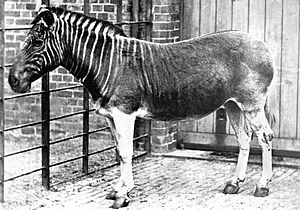Quagga facts for kids
The Quagga (Equus quagga quagga), also called the Cape Quagga, was a type of zebra. It is now extinct, meaning it no longer exists anywhere in the world. The Quagga was special because it only had stripes on its head, neck, and the front part of its body. The rest of its body was a plain yellowish-brown.
It looked a bit like an Okapi and was one of six different kinds of plains zebras. The Quagga lived in the dry, grassy plains of southern Africa. Its name comes from the sound it made, which sounded like "kwa-ka-ka" or "qua-ga-ga".
Quick facts for kids Quagga |
|
|---|---|
 |
|
| Quagga mare at London Zoo, 1870, the only specimen photographed alive | |
| Conservation status | |
| Scientific classification |
|
| Kingdom: | Animalia |
| Phylum: | Chordata |
| Class: | Mammalia |
| Order: | Perissodactyla |
| Family: | Equidae |
| Genus: | Equus |
| Species: | |
| Subspecies: |
†E. q. quagga
|
| Trinomial name | |
| Equus quagga quagga (Boddaert, 1785)
|
|
 |
|
| Former range in red | |
| Synonyms | |
|
List
Hippotigris quagga Hamilton Smith, 1841
Hippotigris isabellinus Hamilton Smith, 1841 E. q. isabellinus Hamilton Smith, 1841 E. q. lorenzi Lydekker, 1902 E. q. greyi Lydekker, 1904 E. q. danielli Pocock, 1904 E. q. trouessarti Camerano, 1908 E. (Quagga) quagga quagga Shortridge, 1934 |
|
Contents
About the Quagga
The Quagga was a unique animal. It was a type of Plains zebra, but it looked quite different. Scientists believe it separated from other plains zebras a very long time ago. This happened between 120,000 and 290,000 years ago.
What it Looked Like
The Quagga had a yellowish-brown body. Its stripes were only on its head, neck, and the front part of its body. The stripes faded away further back on its body. This made it look different from other zebras, which have stripes all over.
Where it Lived
Quaggas lived in the dry, grassy plains of southern Africa. They could be found as far north as the Orange River. These areas were their natural home for thousands of years.
Why it Disappeared
Sadly, the Quagga became extinct because of humans. People hunted them for their meat and their skins. Farmers also hunted them because they thought Quaggas ate too much grass. This grass was needed for their own sheep and goats.
The last wild Quaggas died during a drought in 1878. A drought is a long period with very little rain. The very last Quagga kept in captivity died in the Amsterdam Zoo. This happened on August 12, 1883. Her body is now in a museum. Today, there are 23 Quagga specimens in museums. These include skeletons, skulls, and other bones.
Bringing Them Back?
There is a special project in Africa trying to bring Quaggas back. This group is called the Quagga Project. They are breeding zebras that have very light stripes. The goal is to select zebras that look more and more like the original Quaggas.
The project started in 1987. The first foal (baby zebra) that looked like a Quagga was born in 2005. This project hopes to bring back an animal that was lost forever.
Images for kids
-
1804 illustration by Samuel Daniell, which was the basis of the supposed subspecies E. q. danielli
-
Painting of a stallion in Louis XVI's menagerie at Versailles by Nicolas Maréchal, 1793
-
1777 illustration of a live quagga colt and a bagged adult Burchell's zebra male, by Robert Jacob Gordon
See also
 In Spanish: Cuaga para niños
In Spanish: Cuaga para niños





